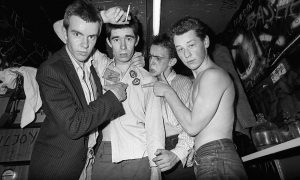“The best solos are something which you can sing as well as the melody line,” says Brian May, guitarist for rock icons Queen. “The kind of solos I enjoy are where there’s a line which reflects the melody line, but subtly changes it in some way which adds to the song.”
As often, Dr. May (surely the only guitar hero with a PhD in astrophysics) is being a little too modest: many of his great solos have not only complemented but transformed the songs they’ve appeared in. By way of celebrating a phenomenal player and all round good guy, born on July 19, 1947, we’ve picked ten of his greatest guitar performances on record with Queen.
It seems only right to open with “Bohemian Rhapsody,” to which May contributes not only a remarkable, timeless solo but some of the most brilliant guitar textures to augment the rest of the band, particularly Freddie Mercury’s lead vocals.
“For me, the guitar is a lead instrument and can be a voice, but it has to be always playing underneath the vocal,” Brian May explained to Guitar Player in 2012. “This is what I tell my guitarists all around the world who play in [the musical] We Will Rock You – be free and be creative, but always remember that if you’re doing something that messes up the vocal, you’re in the wrong playing field.”
Then there’s “Keep Yourself Alive,” track one on Queen’s self-titled first album, and their debut single; and “Stone Cold Crazy,” now often seen as a proto-thrash metal track, which came from 1974’s Sheer Heart Attack, and was a live favorite of the band’s in the 70s.
“Stone Cold Crazy” was one of Queen’s earliest live staples, introduced as early as 1970 but not recorded until their third album Sheer Heart Attack. In just two minutes and 13 seconds, it captured the very essence of the band, and of May’s visceral rock attack. Classic Rock called it “the very essence of 70s Queen: loud, silly, bombastic and fun.”
From 1976’s A Day At The Races comes the great Queen rocker “Tie Your Mother Down,” written by Brian May before the band even existed, improbably on Spanish guitar. “People jump up when they hear it, which is a good feeling,” Brian told Guitar World in 2013.
Big hits underpinned by Brian May’s guitar heroics include the Freddie Mercury song “It’s A Hard Life,” Queen’s third consecutive UK Top 10 success from the album The Miracle in 1984. The dazzling video features Brian playing a unique skull and crossbones guitar.
“Killer Queen,” again from 1973’s Sheer Heart Attack, served early notice of the way that Queen would make May’s incredible sound an integral part of some of their biggest singles. Brian himself described the single as a turning point, heaping praise on Freddie’s performance and those of Roger Taylor and John Deacon. “Of course, I like the solo,” he added, ” with that three-part section, where each part has its own voice. What can I say? It’s vintage Queen.”
The rock’n’roll-flavored “Crazy Little Thing Called Love” became Queen’s first American No.1 single, a wonderful tribute to the music of their forebears and a showcase for Mercury’s sheer sense of showbusiness and fun. But it also highlighted May’s ability to channel his early heroes, notably on a memorable solo that complemented Freddie’s acoustic guitar.
Widely-admired album tracks spotlighting May’s peerless style include “Bijou,” from 1991’s Innuendoand introduced by a searing, evocative figure by the guitar hero. It was said to have been the result of a session he had with Mercury at the piano that lasted just one hour.
No such list would be complete without an example of the band in their live pomp. To capture the flavor of a Queen show, we’ve chosen the version of “Brighton Rock” that was included on the soundtrack of the smash-hit film Bohemian Rhapsody.
The playlist concludes with the solo that Brian himself has said is his own favorite, from “Was It All Worth It,” the Freddie Mercury composition on 1989’s The Miracle. “It’s got a killer solo on it,” May observed. “I pick up and down on those arpeggios. I can do it for short periods, but after that my brain short-circuits and my hand gets confused. I actually like those rising lines. I like lines that suggest harmonic content. I tend to play across chords rather than along lines,” he reflected.
“I don’t think as a guitar player my technique changed that much from the beginning to the end,” May told Guitar Player. “What changed was just the experience in getting the ideas to their fruition.”
Listen to the best of Queen on Apple Music and Spotify for more of Brian May’s phenomenal work with this legendary band.




